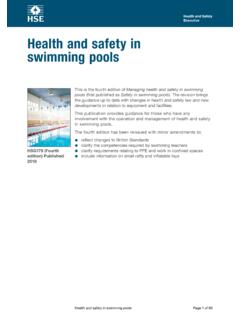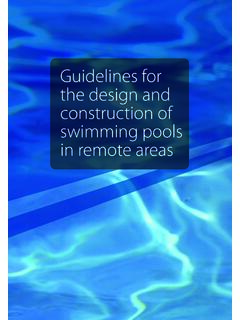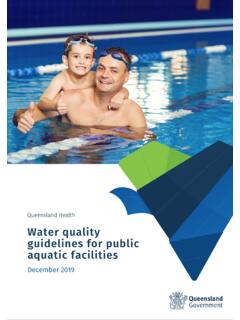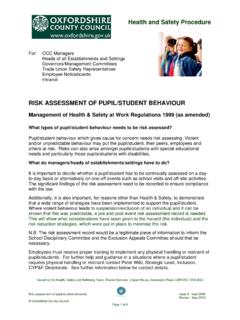Transcription of Risk Management for Your Aquatic Safety Program
1 MARKELINSURANCECOMPANYRisk Management for YourAquatic Safety Program By Will Evans, Director of Safety Education, Markel Insurance Company 2004 Markel Insurance CompanyThe purpose of these materials is to provide professionals with recognized Safety procedures and precautions. These materials should be treated as generalguidelines that could be adopted or modified to meet the specific demands of each facility. The authors do not warrant, guarantee, or ensure that compliance with these guidelines will mitigate or prevent any or all injury or loss that may be caused by orassociated with any person s use of facilities, equipment, or other items or activities that are the subject of these guidelines; nor do the authors assume anyresponsibility or liability for any such injury or loss. Further, the authors hereby expressly disclaim any responsibility, liability, or duty to those facilities, directors,and staff receiving these materials, and any facility clients or their families, for any such liability arising out of injury or loss to any person by the failure of suchfacility, directors, or staff to adhere to these guidelines.
2 1 RiskManagement for YourAquatic Safety ProgramIntroductionDrowning and spinal injuries at swimming pools and aquaticareas are some of the most traumatic and costly events anyprogram can face. The trauma is not restricted to the childwho is injured or dies, but encompasses the family, lifeguards,facility staff, and community. A death or injury claim involvingdrowning can result in multimillion dollar awards and signifi-cant, undesirable media attention. In June 2002, the World Congress on Drowning adopted amore appropriate, uniform definition of drowning: Drowningis the process of experiencing respiratory impairment from sub-mersion/immersion in liquid. Under this definition, drowningis a process that can be interrupted, by rescue for example. Thisnew definition excised the use of the term near-drowning. The National Safe Kids Campaign estimates 5,000 chil-dren ages 14 and under are hospitalized annually as a result ofdrowning incidents; 15% die in the hospital, and as many as20% suffer severe, permanent neurological disability.
3 The typi-cal medical costs for a drowning victim who survives the eventcan range from $75,000 for initial emergency room treatmentto $180,000 a year for long-term care. Costs for caring for adrowning victim who suffers brain damage can be more than$ million. These figures do not include legal fees, court-awarded judgments, damage to the Program s reputation(which could impact donations), or bystander claims from factors make a youth Program drowning very diffi-cult to defend in court: it s reasonable to expect the facility tobe maintained safely, and it s reasonable to expect appropriate-ly trained supervisory personnel on the job during Safety guide discusses the major areas that aquaticmanagers must address: Principal causes of drowning Staff certification and training Rescue equipment and emergency procedures Communications equipment Facility design Managing visiting groupsAppendix A is an Aquatic Safety checklist you can use at Certification and TrainingStaffing qualified lifeguards, and training them to follow yourorganization s specific procedures, is the first step toward asuccessful Aquatic Program .
4 Aquatic administrators shouldaddress two separate areas of training: Lifeguard certification by an outside organization ( ,American Red Cross, Jeff Ellis, USLA, YMCA). In-service, facility-specific training designed to verify andimprove lifeguards skills and teamwork. Every Aquatic facility should have emergency and operationalprocedures that address the hazards, activities, and patronsspecific to their organization. Due to the variety in quality andcontent of lifeguard certification programs , Aquatic directorsshould not rely on them as the sole means of staff training. It is advisable to work with an aquatics professional to design an in-service and skills testing Program to address your site-specific CertificationOver the past few years, there have been a number of signifi-cant course revisions within the American Red Cross andYMCA Aquatic programs . Training priorities have changed andsome courses have been eliminated or revised.
5 For example,the American Red Cross Head Lifeguard course has beenreplaced by Lifeguard Manager. The following is a list of cours-es offered by the major lifeguard training organizations:Principal Causes of DrowningIn a controlled environment, after you eliminate the alcoholfactor, there are three primary causes of drowning and spinalinjuries: unsafe conditions, unsafe acts, and errors in judgment. Errors in Judgment Desire to please othersTrying to adhere to a scheduleMisperceptionNew or unexpectedsituationFatigueDistractionMis communicationDisregarding instinctsUnsafe ActsInadequate rescueequipmentInadequate instructionInadequate supervisionShallow water divesInadequate food/drinkor medicationPoor position of lifeguardUnauthorized orimproper procedureFailure of lifeguard touse corrective eyewearUnsafe ConditionsBroken equipmentInadequate area securityWeatherObstructed viewCloudy waterZone of coverage is too largePhysical profile of participants/staffInappropriate rails on diving boardsInsufficient depth ofwater beneath divingboard or an object/person in the waterUltimately, responsibility for the health and Safety of pro-gram participants, visitors, and staff falls on the facility direc-tor.
6 The responsibility (liability) of an Aquatic Program extendsbeyond the water to the deck or beach area (electrical appli-ances, glass hazards, inappropriate patron behavior) and intolocker rooms and showers (slip hazards and areas for potentialsexual molestation). Pool facilities must also provide a safeenvironment for contractors who come to your site. Falls intounguarded pits in pump rooms, inhalation of powder or gaschlorine, and injuries from slip-and-fall accidents could resultin claims against your organization. 3*Note: The USLA Program certifies employers who provide in-house training to their lifeguards. It is, in effect, an accreditationprogram for employers who wish to fully control their training programs . Lifeguards trained under the Program are not certifiedby USLA, and recognition of the training is limited to the agency that conducted the training. USLA s programs cover still-waterand surf beaches, but not clients are licensed for theirentire Aquatic Program , whichincludes lifeguard training, equip-ment requirements, operationalaudits, and site inspections.
7 Non-clients may receive a CourseCompletion card upon successfulcompletion of lifeguard are skill based and mayvary in 24 hours. 10-hourrenewal course. Instructor mayteach lifeguarding, CPR, first aid,and AED. Program Coordinator authorized totrain in-house swimming hour Basic Leadership TrainingProgram (BLT). Designed as a facili-tated Program to provide training foraquatic leadership Facilities Training Lifeguardcourse is approximately 24 hours,skill based, and appropriate to open-water environments and hours of lifeguard training, plus21 hours of first aid training, plusCPR for professionals1,000 hours of lifeguard experience,plus high school diploma, plusappropriate first aid and CPR teach-ing Hours (CPR, First Aid, AED,Oxygen Administration are prereq-uisites)ARC, ASHI, AHA, and NSC havecourses that meet YMCA prereq-uisite hours. (LGI is not authorized toteach CPR, First Aid, AED, orOxygen Administration).Fundamentals of Teaching YMCASwim Lessons (16 hours)YMCA Swim Lessons: PreschoolInstructor (8 hours)YMCA Swim Lessons:Parent/Child Instructor (8 hours)YMCA Youth and Adult Instructor(12 hours)YMCA Aquatic Management (32hours).
8 Includes basic aquaticsprogram development and man-agement, Program promotion,communication, lifeguard man-agement, Aquatic facility manage-ment, professional developmentand Management skills. Included in YMCA Management includedin YMCA Aquatic Red CrossJeff Ellis and Lifesaving Association (USLA)YMCAL ifeguarding hours, including hourpre-course 27 hours including6-hour precourse. Instructors mayteach lifeguard training, lifeguardmgt., first aid, CPR and AEDE quipment, Oxygen Administration,and Preventing Disease hours for instructors of swim-ming and water Safety hour course designed to prepare lifeguard supervisors formanaging lifeguards. This coursereplaces the prior certification ofHead hour course designed to expandupon Lifeguard training course toinclude waterfront emergencies,surveillance and Instructor CoursesWater Safety Instructor CoursesLifeguard Manager CoursesWaterfront Lifeguard Module 4 Lifeguard Management CoursesThe American Red Cross, Ellis and Associates, and YMCA haveprovided Lifeguard Management courses for several years.
9 Thecourses are designed for people who supervise lifeguards, andcover topics such as selecting and training lifeguards, inspect-ing facilities, and managing an aquatics Program . The training is recommended not only for those who havedirect supervisory responsibilities for lifeguards, but also forpeople who have overall responsibilities for lifeguards. TheAmerican Red Cross Lifeguard Management course is class-room only (no in-water elements) and has no pre-course skillsrequirements. Any currently certified Lifeguard Instructor canteach the course. Markel recommends that at least one facility memberbecomes certified in Lifeguard Management or has document-ed training to the equivalent level. That person should also beat least 21 years old, and have a minimum of six weeks ofexperience in a Management /supervisory position in a similaraquatics Program . See Appendix B for additional courses available to TrainingIf your lifeguards received training from several different orga-nizations, your in-service training becomes even more criticalfor consistent responses and teamwork.
10 The following lists the skills that you can incorporate intoyour in-service training Program , depending on your organiza-tion s activities, equipment, and conditions: Bag-valve mask and oxygen therapy. Deep-water back boarding with a lifejacket on victim (lifejacket creates a challenge for head stabilization andneck alignment). Submerged victim search patterns for zones of coverage totake place in under three minutes (longer than that andlifeguards are doing body recoveries, not rescues). Rescue breathing in deep- and shallow-water conditions. Stabilizing a fractured leg in deep water from a waterskiing injury. Retrieval of a weight representative of a 180-pound personin 12 feet of water. Submerged victim search with the use of fins and face mask. Victim retrieval practice with a rescue board or other rescue device. Multiple victim retrieval practice (simulated lightning strike). Unruly patron intervention. Retrieving multiple boats blown by the wind.









